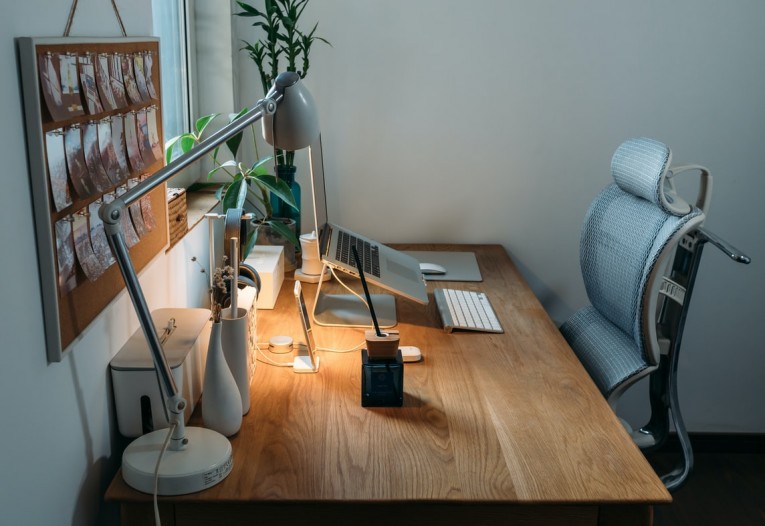Do your shoulders, neck or back ever hurt after a day in front of your computer?
It can easily happen when we sit down for long periods, and on average many of us spend 7 hours plus a day sitting at desks on computers or laptops. This significant amount of time at a desk can lead to a host of problems with your health, so it’s worth making sure you’re set up well. Particularly in the current environment with many more people working from home long term, it’s important to know how to set up your home office as ergonomically as possible.
The more comfortable you are at work, the more likely you are to be focussed and productive. This involves making sure your equipment is properly set up, and that your postural habits are keeping your spine supported.
- Is your screen level? Adjust the monitor height so that the top of the screen is at—or slightly below—eye level. If your monitor does not have height adjustment try elevating it with a raiser, or even some old books.Your eyes should look slightly downward when viewing the middle of the screen. Position the monitor at least 20 inches (51 cm) from your eyes—about an arm's length distance. If your screen is larger, add more viewing distance.
- Keep your mouse close. It’s easy for your mouse to drift away from you when working, make sure you are not over-stretching to reach it. A cordless or Bluetooth mouse helps you to keep it close by, and it can help to tape your mousepad to the desk in the correct position so it doesn’t drift throughout the day.
- Keep your keyboard close. You should be able to sit up in your chair, have your elbows in an L-shape and still be able to reach your keyboard. If you are overstretching to reach it, you will need to make adjustments.
- Adjust your chair. You should be able to sit right back into your chair, so your lower back is supported while still comfortably accessing your equipment. Ideally having an ergonomic workchair which allows you to tilt the angle of the chair, as well as adjust the height, will help you to find a position that works for your unique requirements. It is important to have arm support in the form of armrests.
- Feet to the floor. The height of your chair should allow your feet to easily reach flat to the floor. Your knees should be either at the same height or ideally just below your hips. An alternative here to take strain off the hip flexors is to use a footrest under the desk.
- Avoid crossing your legs. It can cause circulation problems and puts unnecessary strain through your lower back.
If you are unsure about your desk or workstation set-up, ask your employers to provide a workstation assessment. Our team of osteopaths can also advise you on setting up your workstation ergonomically.
Take Regular Breaks
It is recommended that you should take a break from your desk every 30 minutes for at least one or two minutes. Try building in some of these good habits into your working day:
- Stand and move around for a few moments around your desk,
- Use a break to get a drink of water, which also helps you keep hydrated.
- Rather than phoning an office colleague, can you walk over to talk to them?
- When taking a call, you can take the opportunity to stand up rather than sit?
On The Phone
If your work involves making lots of calls, avoid tucking handsets between your neck and shoulder. Consider getting a headset so you are not battling with the handset, keeping your hands free and able to maintain a healthy posture. Additionally, the phone set shouldn’t be too far away – like your keyboard and mouse, you shouldn’t have to stretch to reach it.
Laptop Working
Increasingly we are working directly off laptops, particularly if you are mobile or remote worker or hot-desking across offices. However, the same rules apply and even more so if you don't have the luxury of an adjustable chair or monitor.
- If you are mainly working off a laptop you may want to consider getting a wireless keyboard and/or raisers so you can optimise your work posture.
- Also consider where you work - your dining room table may be convenient but if of an incorrect height, extended working may cause shoulder, neck or back pain.

Stretches And Exercises At Your Desk
Try these exercises which have been designed for you to do at your desk, to help ease the strain:
1. Seated Spinal Rotation
- While seated, cross your arms over your chest.
- Grab your shoulders.
- Rotate your upper body from the waist, turning gently from left to right as far as you can. Look over your shoulder as you turn.
- You should feel a tension on both side of your lower back as it stretches out.
2. Posterior Shoulder Stretch
- Reach across your body and past the opposite shoulder.
- Pull your elbow into your chest.
- You should feel your shoulder gently stretching.
3. Shoulder Shrugs
- Gently lift your shoulders.
- Let them slowly fall.
- You should feel tension being released as your shoulders drop.
4. Sitting Back Extensions
- Sit straight with your feet together.
- Put the palms of your hands into the small of your back.
- Lean back over your hands, feeling your lower back stretch out.
5. Neck Rotations
- Keep your head upright.
- Gently turn your head from side to side.
- As you turn your head, try to move it past your shoulder.
- You should feel the muscles on the outside of your neck gradually stretching.
6. Upper Shoulder and Neck Stretch
- Sit on one hand
- Tilt your head away from the hand you're sitting on.
- Tilt your head slightly forward, towards your shoulder.
- You should feel the muscles in your neck and shoulder being stretched.
- Change sides and repeat.
7. Shoulder Extension - One
- Stand up and stretch your arms out behind you.
- Clasp your hands together and gently lift your arms.
- You should feel the pressure in your shoulders ease off.
8. Shoulder Extension - Two
- Hold both arms above your head.
- Link your hands with your palms facing upwards.
- Reach as high as possible.
- You should feel your shoulders stretching.
Some of the exercises can be difficult if your joints are restricted and/or muscles tight. Osteopathy will help to remove these restrictions and relax your tight muscles, so that moving forward you are able to better self-manage your posture through stretching and good ergonomic setup.
If you would like to consult with an osteopath, please contact us on 03 3518 262 or book an appointment online.
Back to blog
